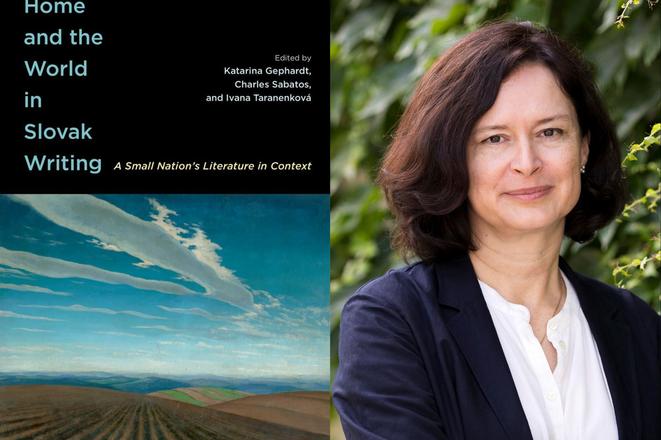When Katarina Gephardt, a Slovak-born professor of English at Kennesaw State University in the United States, set out in 2007 to create a study programme on Slovak and other Central European literatures, she realised that there were virtually no English-language resources on Slovak literature, and translations were scarce.
Katarina Gephardt
She is professor of English at Kennesaw State University, Georgia, USA. She has published a monograph entitled The Idea of Europe in Nineteenth-Century British Travel Narratives, 1789-1914 and essays on 19th century British literature, travel writing, Slovak literature, and pedagogy. She is currently working on a monograph on nineteenth-century British women’s travel writing on Central and Eastern Europe.
During the past decade, Gephardt noticed that the number of English translations of Slovak literature was growing and saw an opportunity. “Maybe it’s the right moment,” she thought, “to create a book about Slovak literature in English – for scholars, literature lovers, and anyone curious to explore Slovak culture more deeply,” she tells The Slovak Spectator.
First, she contacted Julia Sherwood, a Slovak-born translator and promoter of Slovak literature who lives in London, for recommendations of experts in Slovak literature and an idea of publishing a book gradually took shape. "Home and the World in Slovak Writing: A Small Nation’s Literature in Context" was published by the Canadian publishing house McGill-Queen's University Press in March 2025.
At a book launch event in London, Tim Beasley-Murray, who has long worked with Slovak literature at University College London, described the work as “confident” – that it didn’t apologise for itself, nor did it cling to grand myths of national identity or exhibit the kind of inferiority complex that sometimes limits Slovak self-representations, according to Gephardt.
“That was exactly what we were aiming for, and it was encouraging to hear,” says Gephardt. “This new tone of self-assurance, I believe, is something quite distinct in today’s Slovak literature, and it offers a fresh and powerful voice within the landscape of small literatures.”
The Slovak Spectator spoke with Gephardt about the process of creation of "Home and the World in Slovak Writing", why it is important to publish such books, which Slovak books have the potential to succeed outside Slovakia, and more.
Where did the idea for this book come from?
Home and the World in Slovak Writing: A Small Nation’s Literature in Context
Literatures of small nations represent a minuscule portion of the global literary marketplace, where books written in English outnumber translated works. The struggle for visibility in relation to dominant languages and cultures is not new in Slovakia, a nation of five million whose literary history has been shaped by the influence of more widely spoken languages including Hungarian, Czech, and Russian. The book brings Slovak literature out of this isolation to tell the story of how a nation’s literature can survive and thrive despite a small domestic audience and relatively limited circulation in English translation. The book demonstrates how historic events such as the post-Stalin Thaw, the Prague Spring, and the Velvet Revolution moulded the Slovak canon and situates contemporary Slovak literature in broader regional and global contexts.
The idea first emerged in 2007 when I was preparing a study programme focused on Central European literature. Very early on I realised there were very few secondary sources on Slovak literature. There weren’t many translations at that point either, and there was also very little secondary information on Czech, Hungarian and other Central European literatures – certainly nothing that could guide English-speaking students or instructors unfamiliar with the field. As the number of translations slowly began to increase – thanks in part to the efforts of people like Julia Sherwood – I started thinking more seriously about creating an English-language resource on Slovak literature. The idea was to map trends and key texts, and introduce English speaking readers to the historical and cultural contexts of Slovak literature. Paradoxically, I ended up writing a book I had once needed myself.
Although the idea had first come about years earlier, it took time to find the right collaborators and a supportive publisher - the Canadian publishing house McGill-Queen’s University Press. Eventually, with the encouragement of Julia Sherwood, and the input of my co-editors, Ivana Taranenková, and Charles Sabatos, the project took shape. My co-editors’ expertise played an essential role in the development of the book, since Ivana is the director of the Institute of Slovak Literature of the Slovak Academy of Sciences who recently co-authored a book on contemporary Slovak literature and Charles Sabatos is U.S.-born translator of Slovak literature and a comparative literature scholar who teaches at Yeditepe University in Istanbul, Turkey. The chapters include insights from scholars who come from different countries, including Slovakia, Poland, the United Kingdom, Canada, the United States, which made it possible for us to bridge domestic and international perspectives on Slovak literature that had been typically separate in the past, in a productive dialogue.
The only comparable prior work was "A History of Slovak Literature" by Peter Petro from the 1990s, which was also published by McGill-Queen’s and aside from that and one other book edited by Robert Pynsent, there had been no substantial English-language secondary source on Slovak literature in nearly 30 years. This new book fills that long-standing gap.
What to look out for in this interview:
For which readers is this book intended
Why writing books like these matters
What Slovak literature has to offer in terms of form, genre, and theme
Which kinds of Slovak books could make it internationally
Slovak authors whose translated works have already found success abroad


